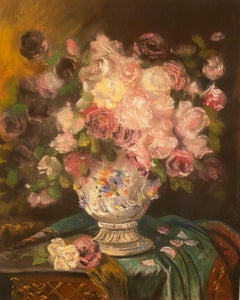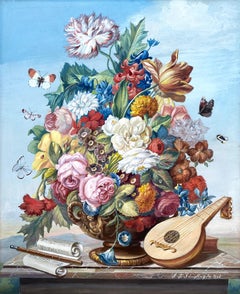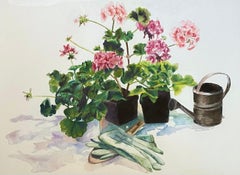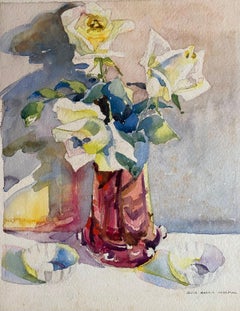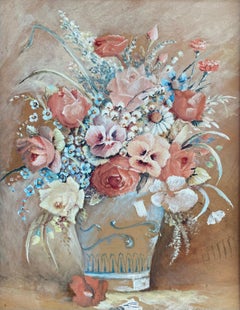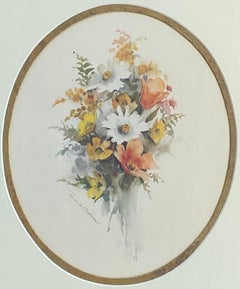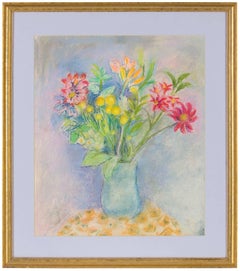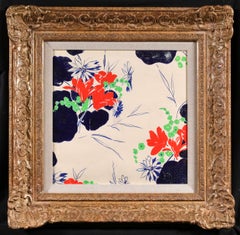Arthur T. Kalaher Fine Art Still-life Drawings and Watercolors
to
7
6
2
Overall Width
to
Overall Height
to
8
2
1
1
1
2
1
3
2
1
5
1
4
3
3
2
2
1
1
1
1
1
1
1
7
7
7
6
2
1
8
8
“Roses in a Porcelain Vase”
By Marcel Vertès
Located in Southampton, NY
Here for your consideration is a very well executed oil pastel on archival paper by the well known French artist, Marcel Vertes. Signed lower right. Condition is excellent. Circa 1...
Category
1930s Post-Impressionist Still-life Drawings and Watercolors
Materials
Oil Pastel, Archival Paper
“Floral Bouquet with Mandolin”
Located in Southampton, NY
Beautiful floral watercolor and gouache on paper with musical instruments by the German artist, Friedrich (Frederick) Jungling. Signed lower right and dated 1908. Excellent condition...
Category
Early 1900s Academic Still-life Drawings and Watercolors
Materials
Watercolor, Gouache, Archival Paper
$2,880 Sale Price
20% Off
“Geraniums”
Located in Southampton, NY
Very well painted original watercolor on archival paper of potted geraniums with metal watering can and garden gloves. Signed in pencil by the artist Peggy Dressel lower right. The S...
Category
1980s Contemporary Still-life Drawings and Watercolors
Materials
Watercolor, Archival Paper
$575 Sale Price
23% Off
“Still Life with White Roses”
Located in Southampton, NY
Beautiful original watercolor by Jessie Harris Bone Charman. Signed lower right. Circa 1940. Condition is very good. Under glass. Beautifully matted and framed. Overall framed mea...
Category
1940s Modern Still-life Drawings and Watercolors
Materials
Watercolor, Archival Paper
$960 Sale Price
20% Off
“Roses and Pansies”
Located in Southampton, NY
Very well executed watercolor and gouache on heavy card stock of a spring bouquet composed of mainly roses and pansies. Unsigned. Circa 1915. Original gold painted wood frame. Under...
Category
1910s Post-Impressionist Still-life Drawings and Watercolors
Materials
Watercolor, Gouache, Cardboard
$300 Sale Price
20% Off
“Spring Bouquet 2”
By Rosalind Oesterle
Located in Southampton, NY
Original watercolor on archival paper by Rosalind Oesterle. Circa 1970. Signed lower left by the artist. Oval format. Condition is excellent. Profe...
Category
1970s Contemporary Still-life Drawings and Watercolors
Materials
Watercolor, Archival Paper
$360 Sale Price
20% Off
“Spring Bouquet”
By Rosalind Oesterle
Located in Southampton, NY
Original watercolor on archival paper by Rosalind Oesterle. Circa 1970. Signed lower left by the artist. Oval format. Condition is excellent. Profe...
Category
1970s Contemporary Still-life Drawings and Watercolors
Materials
Watercolor, Archival Paper
$360 Sale Price
20% Off
"Daffodils in Ceramic Pitcher"
Located in Southampton, NY
Here for your consideration is a beautiful watercolor still life on heavy paper by the German artist, E. Riehle. Signed and dated lower right, 1903. In good condition with it's orig...
Category
Early 1900s Academic Still-life Drawings and Watercolors
Materials
Paper, Watercolor
$850 Sale Price
29% Off
Related Items
Springtime Floral Bouquet
Located in Surfside, FL
Pastel, circa 20th century
Category
20th Century Modern Still-life Drawings and Watercolors
Materials
Paper, Oil Pastel
Projet de Tissus - Fauvist Flowers Watercolor & Gouache by Raoul Dufy
By Raoul Dufy
Located in Marlow, Buckinghamshire
Botanical watercolour and gouache on paper circa 1920 by French fauvist painter Raoul Dufy. The work depicts flowers in red, blue and green. This work was executed by Dufy as a fabric design.
Dimensions:
Framed: 19.5"x19.5"
Unframed: 12"x12"
Provenance:
Private collection of works by Raoul Dufy for Bianchini Ferier
Bianchini Ferrier Collection - Christie's London - July 2001
SF Fall Show
Raoul Dufy was one of a family of nine children, including five sisters and a younger brother, Jean Dufy, also destined to become a painter. Their father was an accountant in the employ of a major company in Le Havre. The Dufy family was musically gifted: his father was an organist, as was his brother Léon, and his youngest brother Gaston was an accomplished flautist who later worked as a music critic in Paris. Raoul Dufy's studies were interrupted at the age of 14, when he had to contribute to the family income. He took a job with an importer of Brazilian coffee, but still found time from 1892 to attend evening courses in drawing and composition at the local college of fine arts under Charles Marie Lhullier, former teacher of Othon Friesz and Georges Braque. He spent his free time in museums, admiring the paintings of Eugène Boudin in Le Havre and The Justice of Trajan in Rouen. A municipal scholarship enabled him to leave for Paris in 1900, where he lodged initially with Othon Friesz. He was accepted by the École des Beaux-Arts, where he studied under Léon Bonnat, whose innate conservatism prompted Dufy to remark later that it was 'good to be at the Beaux-Arts providing one knew one could leave'.
And leave he did, four years later, embarking with friends and fellow students on the rounds of the major Paris galleries - Ambroise Vollard, Durand-Ruel, Eugène Blot and Berheim-Jeune. For Dufy and his contemporaries, Impressionism represented a rejection of sterile academism in favour of the open-air canvases of Manet, the light and bright colours of the Impressionists, and, beyond them, the daringly innovative work of Gauguin and Van Gogh, Seurat, Cézanne, Toulouse-Lautrec and others. Dufy was an out-and-out individualist, however, and was not tempted to imitate any of these artists. He produced, between 1935 and 1937, Fée Electricité (Spirit of Electricity), the emblem for the French utilities company Electricité de France (EDF).
Dufy visited the USA for the first time in 1937, as a member of the Carnegie Prize jury. In 1940, the outbreak of war (and his increasingly rheumatic condition) persuaded him to settle in Nice. When he eventually returned to Paris 10 years later, his rheumatism had become so debilitating that he immediately left for Boston to follow a course of pioneering anti-cortisone treatment. He continued working, however, spending time first in Harvard and then in New York City before moving to the drier climate of Tucson, Arizona. The cortisone treatment was by and large unsuccessful, although he did recover the use of his fingers. He returned to Paris in 1951 and decided to settle in Forcalquier, where the climate was more clement. Within a short time, however, he was wheelchair-bound. He died in Forcalquier in March 1953 and was buried in Cimiez.
Between 1895 and 1898, Raoul Dufy painted watercolours of landscapes near his native Le Havre and around Honfleur and Falaise. By the turn of the century, however, he was already painting certain subjects that were to become hallmarks of his work - flag-decked Parisian cityscapes, Normandy beaches teeming with visitors, regattas and the like, including one of his better-known early works, Landing Stage at Ste-Adresse. By 1905-1906 Friesz, Braque, Matisse, Derain, Vlaminck, Van Dongen and Rouault were described collectively as Fauves (the wild beasts). What they had in common was a desire to innovate, but they felt constrained nonetheless to meet formally to set out the guiding principles of what promised to be a new 'movement'. Dufy quickly established that those principles were acceptable; moreover, he was most impressed by one particular painting by Henri Matisse ( Luxury, Calm and Voluptuousness) which, to Dufy, embodied both novelty and a sense of artistic freedom. Dufy promptly aligned himself with the Fauves. Together with Albert Marquet in particular, he spent his time travelling the Normandy coast and painting views similar...
Category
1920s Fauvist Still-life Drawings and Watercolors
Materials
Paper, Watercolor, Gouache
$12,678
H 19.5 in W 19.5 in
'Tall Tulips' bespoke watercolor
By Gary Bukovnik
Located in Burlingame, CA
'Tall Tulips' original watercolor painted in 2021 in subtle shades of pink with hints of yellow in a clear blue vase from Cleveland-born and educated Gary Bukovnik who has lived in California for over 40 years. Bukovnik’s art conveys a monumental quality. Primarily using the mediums of watercolor, monotype, and lithograph, Bukovnik fuses sensual vitality with fluid yet powerful colorations, creating floral images of great depth and intensity.
The paper is 40 x 20 inches. Ships flat and unframed. Although professional framing is available upon request. This is a stunning and wonderful work of art from Gary Bukovnik.
In 2003 and 2005, the American Academy in Rome invited Bukovnik to
attend the academy as a Visiting Artist and provided him with a room and studio for six weeks. In 2001, he was selected to create a poster for the prestigious List Collection, which creates posters to commemorate programs at Lincoln Center for the Performing Arts in New York. Lincoln Center past contributors have included Roy Lichtenstein, Andy Warhol, Robert Motherwell, Helen Frankenthaler, Alex Katz, Elizabeth Murray, and Donald Sultan.
Solo exhibitions include Caldwell Snyder Gallery in San Francisco and in St.
Helena, CA; Trajan Gallery in Carmel, CA; Campton Gallery in New York City; Concept Gallery in Pittsburgh, PA; Elins Eagles-Smith Gallery and A.C.T. Gallery in San Francisco, the Bonfoey Gallery in Cleveland and the Erickson Fine Art Gallery in Healdsburg. Other recent exhibitions have been organized by the Butler Institute of American Art, Youngstown, Paula Brown Gallery, Toledo, Neuhoff Gallery, New York; Lisa Kurts Gallery, Memphis; Irving Galleries, Palm Beach; Galerie Kutter, Luxembourg; the Southern Alleghenies.
Museum of Art, Johnstown, Pennsylvania; Chin Show Cultural Center, Taipei; Takashimaya, Tokyo; the Hunt Institute for Botanical Documentation, Carnegie Mellon University, Pittsburgh; and Brevard Museum of Art, Melbourne, Florida. Among the artwork displayed at the Brevard Museum of Art was a tapestry based on a Bukovnik watercolor and hand-woven in Aubusson, France by Atelier Raymond Picaud, weavers since the eventeenth century. Atelier Raymond Picaud has been at the forefront of progressive tapestry firms since the 1930s, focusing on images of modern artists such as Alexander Calder, Georges Braque, and Helen Frankenthaler.
Bukovnik’s watercolors and monotypes are the subject of Flowers: Gary Bukovnik Watercolors & Monotypes, published by Harry N. Abrams, New York. This book includes a foreword by James J. White, curator at the Hunt Institute for Botanical Documentation; an interview with the artist
by Robert Flynn Johnson, curator at the Fine Arts Museums of San Francisco; and an essay about Bukovnik and the depiction of flowers in art...
Category
21st Century and Contemporary Contemporary Still-life Drawings and Water...
Materials
Watercolor, Archival Paper
"Some far away speech" Still life, Ink and watercolor
By Brian Spolans
Located in Philadelphia, PA
"Some far away speech" is an original ink and watercolor work on paper by Brian Spolans. The piece ships framed as pictured and measures 20.5in x 28.5in. Alternative custom framing...
Category
2010s Contemporary Still-life Drawings and Watercolors
Materials
Ink, Watercolor, Archival Paper
Flower Vase, Yellow Watercolor painting on paper
By Manuel Santelices
Located in Miami Beach, FL
A new series inspired by architecture, décor and stylish personalities of the world of interior design.
The worlds of fashion, society and pop culture are captured in the illustrati...
Category
21st Century and Contemporary Contemporary Paintings
Materials
Paper, Watercolor, Archival Paper
The Red Chair, Pop Art, Circle of David Hockney. Oil Pastel.
Located in Cotignac, FR
Pastel and crayon on paper interior scene by Eileen Gore Sellon. The painting is signed bottom left and attributed and dated to the backboard. Presented in gilt wood frame with mount...
Category
Late 20th Century Pop Art Still-life Drawings and Watercolors
Materials
Oil Pastel, Pastel, Paper
$756 Sale Price
20% Off
H 16.93 in W 16.74 in D 0.6 in
Projet de Fleurs - Fauvist Flowers Gouache by Raoul Dufy
By Raoul Dufy
Located in Marlow, Buckinghamshire
Botanical gouache on paper circa 1920 by French fauvist painter Raoul Dufy. The work flowers in red and blues with green foliage against a yellow and white stripped background.
Dimensions:
Framed: 25"x20"
Unframed: 18"x13"
Raoul Dufy was one of a family of nine children, including five sisters and a younger brother, Jean Dufy, also destined to become a painter. Their father was an accountant in the employ of a major company in Le Havre. The Dufy family was musically gifted: his father was an organist, as was his brother Léon, and his youngest brother Gaston was an accomplished flautist who later worked as a music critic in Paris. Raoul Dufy's studies were interrupted at the age of 14, when he had to contribute to the family income. He took a job with an importer of Brazilian coffee, but still found time from 1892 to attend evening courses in drawing and composition at the local college of fine arts under Charles Marie Lhullier, former teacher of Othon Friesz and Georges Braque. He spent his free time in museums, admiring the paintings of Eugène Boudin in Le Havre and The Justice of Trajan in Rouen. A municipal scholarship enabled him to leave for Paris in 1900, where he lodged initially with Othon Friesz. He was accepted by the École des Beaux-Arts, where he studied under Léon Bonnat, whose innate conservatism prompted Dufy to remark later that it was 'good to be at the Beaux-Arts providing one knew one could leave'.
And leave he did, four years later, embarking with friends and fellow students on the rounds of the major Paris galleries - Ambroise Vollard, Durand-Ruel, Eugène Blot and Berheim-Jeune. For Dufy and his contemporaries, Impressionism represented a rejection of sterile academism in favour of the open-air canvases of Manet, the light and bright colours of the Impressionists, and, beyond them, the daringly innovative work of Gauguin and Van Gogh, Seurat, Cézanne, Toulouse-Lautrec and others. Dufy was an out-and-out individualist, however, and was not tempted to imitate any of these artists. He produced, between 1935 and 1937, Fée Electricité (Spirit of Electricity), the emblem for the French utilities company Electricité de France (EDF).
Dufy visited the USA for the first time in 1937, as a member of the Carnegie Prize jury. In 1940, the outbreak of war (and his increasingly rheumatic condition) persuaded him to settle in Nice. When he eventually returned to Paris 10 years later, his rheumatism had become so debilitating that he immediately left for Boston to follow a course of pioneering anti-cortisone treatment. He continued working, however, spending time first in Harvard and then in New York City before moving to the drier climate of Tucson, Arizona. The cortisone treatment was by and large unsuccessful, although he did recover the use of his fingers. He returned to Paris in 1951 and decided to settle in Forcalquier, where the climate was more clement. Within a short time, however, he was wheelchair-bound. He died in Forcalquier in March 1953 and was buried in Cimiez.
Between 1895 and 1898, Raoul Dufy painted watercolours of landscapes near his native Le Havre and around Honfleur and Falaise. By the turn of the century, however, he was already painting certain subjects that were to become hallmarks of his work - flag-decked Parisian cityscapes, Normandy beaches teeming with visitors, regattas and the like, including one of his better-known early works, Landing Stage at Ste-Adresse. By 1905-1906 Friesz, Braque, Matisse, Derain, Vlaminck, Van Dongen and Rouault were described collectively as Fauves (the wild beasts). What they had in common was a desire to innovate, but they felt constrained nonetheless to meet formally to set out the guiding principles of what promised to be a new 'movement'. Dufy quickly established that those principles were acceptable; moreover, he was most impressed by one particular painting by Henri Matisse ( Luxury, Calm and Voluptuousness) which, to Dufy, embodied both novelty and a sense of artistic freedom. Dufy promptly aligned himself with the Fauves. Together with Albert Marquet in particular, he spent his time travelling the Normandy coast and painting views similar...
Category
1920s Fauvist Still-life Drawings and Watercolors
Materials
Gouache, Paper
Fleurs et Papillons - Fauvist Flowers Watercolor & Gouache by Raoul Dufy
By Raoul Dufy
Located in Marlow, Buckinghamshire
Botanical watercolour and gouache on paper circa 1920 by French fauvist painter Raoul Dufy. The work depicts flowers in red and butterflies in blues, yellows, black and white. This work was executed by Dufy as a fabric design.
Dimensions:
Framed: 17"x27"
Unframed: 10"x20"
Provenance:
Private collection of works by Raoul Dufy for Bianchini Ferier
Bianchini Ferrier Collection - Christie's London - July 2001
SF Fall Show
Raoul Dufy was one of a family of nine children, including five sisters and a younger brother, Jean Dufy, also destined to become a painter. Their father was an accountant in the employ of a major company in Le Havre. The Dufy family was musically gifted: his father was an organist, as was his brother Léon, and his youngest brother Gaston was an accomplished flautist who later worked as a music critic in Paris. Raoul Dufy's studies were interrupted at the age of 14, when he had to contribute to the family income. He took a job with an importer of Brazilian coffee, but still found time from 1892 to attend evening courses in drawing and composition at the local college of fine arts under Charles Marie Lhullier, former teacher of Othon Friesz and Georges Braque. He spent his free time in museums, admiring the paintings of Eugène Boudin in Le Havre and The Justice of Trajan in Rouen. A municipal scholarship enabled him to leave for Paris in 1900, where he lodged initially with Othon Friesz. He was accepted by the École des Beaux-Arts, where he studied under Léon Bonnat, whose innate conservatism prompted Dufy to remark later that it was 'good to be at the Beaux-Arts providing one knew one could leave'.
And leave he did, four years later, embarking with friends and fellow students on the rounds of the major Paris galleries - Ambroise Vollard, Durand-Ruel, Eugène Blot and Berheim-Jeune. For Dufy and his contemporaries, Impressionism represented a rejection of sterile academism in favour of the open-air canvases of Manet, the light and bright colours of the Impressionists, and, beyond them, the daringly innovative work of Gauguin and Van Gogh, Seurat, Cézanne, Toulouse-Lautrec and others. Dufy was an out-and-out individualist, however, and was not tempted to imitate any of these artists. He produced, between 1935 and 1937, Fée Electricité (Spirit of Electricity), the emblem for the French utilities company Electricité de France (EDF).
Dufy visited the USA for the first time in 1937, as a member of the Carnegie Prize jury. In 1940, the outbreak of war (and his increasingly rheumatic condition) persuaded him to settle in Nice. When he eventually returned to Paris 10 years later, his rheumatism had become so debilitating that he immediately left for Boston to follow a course of pioneering anti-cortisone treatment. He continued working, however, spending time first in Harvard and then in New York City before moving to the drier climate of Tucson, Arizona. The cortisone treatment was by and large unsuccessful, although he did recover the use of his fingers. He returned to Paris in 1951 and decided to settle in Forcalquier, where the climate was more clement. Within a short time, however, he was wheelchair-bound. He died in Forcalquier in March 1953 and was buried in Cimiez.
Between 1895 and 1898, Raoul Dufy painted watercolours of landscapes near his native Le Havre and around Honfleur and Falaise. By the turn of the century, however, he was already painting certain subjects that were to become hallmarks of his work - flag-decked Parisian cityscapes, Normandy beaches teeming with visitors, regattas and the like, including one of his better-known early works, Landing Stage at Ste-Adresse. By 1905-1906 Friesz, Braque, Matisse, Derain, Vlaminck, Van Dongen and Rouault were described collectively as Fauves (the wild beasts). What they had in common was a desire to innovate, but they felt constrained nonetheless to meet formally to set out the guiding principles of what promised to be a new 'movement'. Dufy quickly established that those principles were acceptable; moreover, he was most impressed by one particular painting by Henri Matisse ( Luxury, Calm and Voluptuousness) which, to Dufy, embodied both novelty and a sense of artistic freedom. Dufy promptly aligned himself with the Fauves. Together with Albert Marquet in particular, he spent his time travelling the Normandy coast and painting views similar...
Category
1920s Fauvist Still-life Drawings and Watercolors
Materials
Paper, Watercolor, Gouache
Flying Composition no. 2
By Gary Bukovnik
Located in Burlingame, CA
'Flying Composition no. 2' original watercolor painted in 2021. Large work at 40 x 60 inches, in multi-color including an explosion of blue, orange, yellow, and green from Cleveland-...
Category
21st Century and Contemporary Contemporary Still-life Drawings and Water...
Materials
Watercolor, Archival Paper
Projet de Tissus - Fauvist Still Life Study Gouache by Raoul Dufy
By Raoul Dufy
Located in Marlow, Buckinghamshire
Botanical gouache on paper circa 1920 by French fauvist painter Raoul Dufy. The work depicts a study of apples and pears. This work was executed by Dufy as a fabric design.
Dimensio...
Category
1920s Fauvist Still-life Drawings and Watercolors
Materials
Paper, Gouache
$18,987
H 27 in W 26.75 in
Teapot & Flowers Still-Life, Coastal Seascape Double-Sided Watercolor
By Les Anderson
Located in Soquel, CA
Two-sided watercolor with teapot-and-flower still life on one side and Carmel coast on the other by Les (Leslie Luverne) Anderson (American, 1928-2009). From the estate of Les Anders...
Category
Late 20th Century American Impressionist Still-life Drawings and Waterco...
Materials
Watercolor, Archival Paper
$425
H 23 in W 16 in D 1 in
Flower Pot, Impressionist Gouache Painting by Eugene Baboulene
By Eugene Baboulene
Located in Long Island City, NY
Artist: Eugene Baboulene, French (1905 - 1994)
Title: Flower Pot
Year: circa 1960
Medium: Gouache on Paper, signed and dedicated l.r.
Size: 20 in. x 13 in. ...
Category
1960s Post-Impressionist Still-life Drawings and Watercolors
Materials
Gouache
